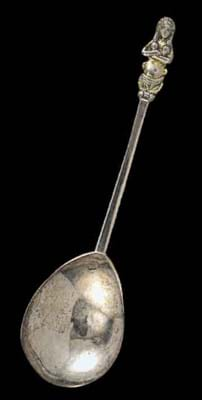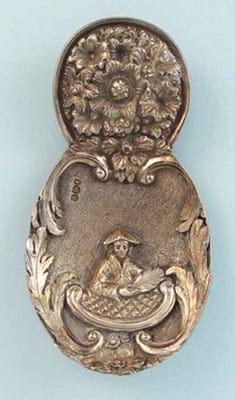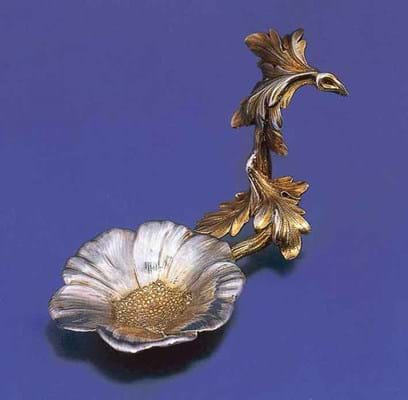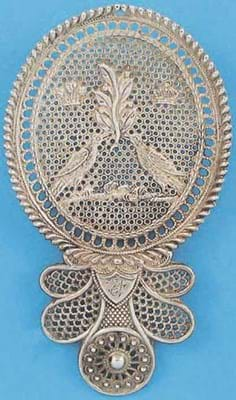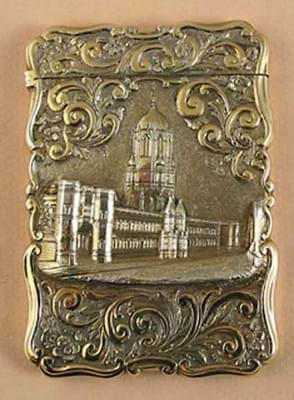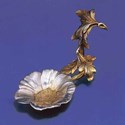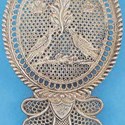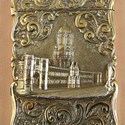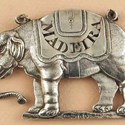There were some 450 examples offered in 253 lots - but remarkably this was just half of the holdings of a former Navy officer and river pilot whose last official post was as president of the Caddy Spoon Society (CSP).
The collection came to Salisbury partly because Mr Norie lived not too far away, but also because of the reputation the firm has for selling spoons following Alexis Butcher's arrival from Christie's four years ago. The London giants have now decided to drop specialist silver spoon sales, his particular area of expertise.
Marketing the sale was not difficult, but a nice extra touch was organising a special view for members of the CSP - a proposition so attractive that a Japanese member flew over from Tokyo to be there - where members met and chatted over old times with Mr Norie's widow.
Come sale day, sentiment was forgotten and self-interest took over. The fact that from the first lot - nine assorted early 19th century mother-of-pearl spoons which took £1100 against a £100-150 estimate - every offering went way above expectations was a manifestation of the market rather than any mood of in memorium. The white-glove sale totted up some £122,000.
"Estimates were conservative but we didn't think unreasonably so" said Mr Butcher. "But in this market if a collector wants a specific piece he or she will bid it up to what they can afford, not what, necessarily, the same sort of spoon has made before. Anyway, so many of these spoons are just about unique that there isn't much in the way of precedent."
Top seller was the final lot in the 253- lot section - a rare, simulated filigree spoon, the bowl centred with two doves supporting an olive branch flanked by Prince of Wales feathers and the Crown.
Carrying only the initialled mark of Birmingham makers Cocks & Bettridge, the c.1820 spoon was estimated at £600-800. Mr Butcher admitted he wouldn't have been surprised to see it go to around £2500, but the final bid of £4600 was truly unexpected.
Going at ten times the upper estimate was a cast and textured spoon with lug handle, chased with flowers and a bowl with the figure of a Chinese tea buyer. Carrying a crest to the reverse, the 1.5oz spoon by Edward Farrell, London, 1820, sold at £4000.
Mr Butcher wanted both tranches of the collection (the next will be offered on July 28) to include a range of spoons. So there were the unusual examples, like the parcel gilt example by Francis Higgins, London 1852, modelled as an anemone, which took £2800, mixed with the more familiar jockey cap spoons (one by Elizabeth Morley, London 1799 took £440), and multiple lots such as three Chester spoons, dating from 1835 to 1913, which went at £240.
The sale also included the firm's biannual offering of early spoons from other vendors. These are often occasions when collectors trade up, getting the best price they can for a lesser piece in order to go for a coveted rarity. What really makes such events is the appearance of a market-fresh collection.
On this occasion there were a number of keenly sought spoons among the 75 lots on offer. The top seller was a 1630-40, 71/2in (19.25cm) example by Robert Matthew of Barnstaple with the Aphrodite finial which seems unique to the town. Dated c.1630-40 and with a pricked C over WT and the date 1658, it left its healthy £2500-3500 estimate behind and sold at £7600.
Small silver collectables remains the strength of the market, Here was a rare silver gilt castle top card case by Nathaniel Mills, Birmingham 1850 depicting Christ Church, Oxford sold at £5200 while members of the Wine Label Circle were out in force for no fewer than 80 lots of wine labels. Some labels could be had for a couple of hundred pounds or so but rare forms, rare names and provincial assays tended to mean four-figure bids.
For instance, a 1.5oz example for Claret by Paul Storr, 1815, with a rare lion's pelt decoration, took £2400, while the best seller - illustrated on the catalogue front cover - took the form of a stamped and cut out elephant with a decorative saddle cloth pierced with the word Madeira.
Dated London 1814, it had the maker's mark D.H., possibly for David Hockley, and against a £1500-2000 estimate sold at £4600.
The buyer's premium was 15/10% per cent.

